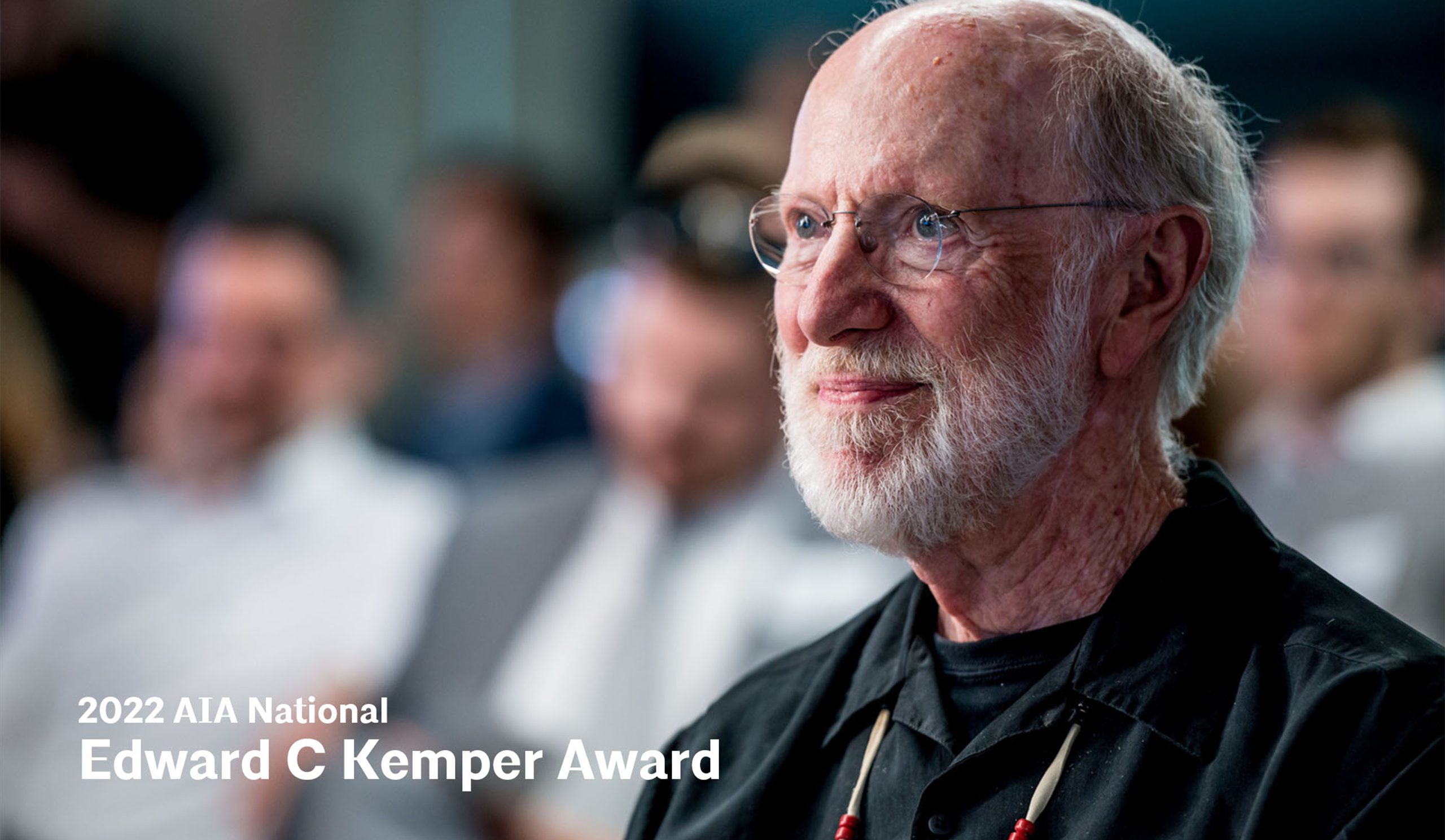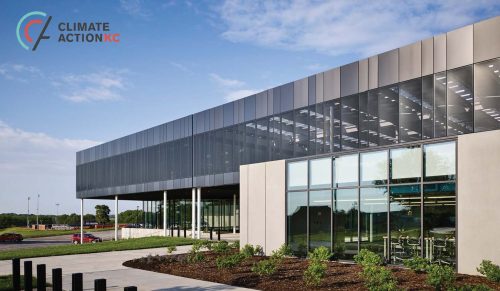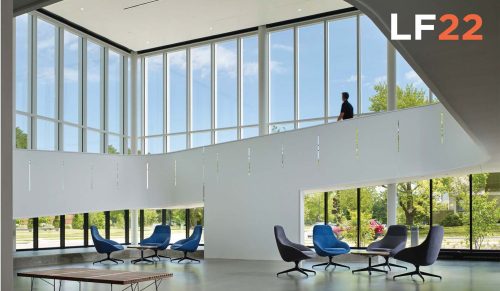Spotlight

Bob Berkebile honored with 2022 Edward C. Kemper Award
Bob Berkebile, FAIA, founding principal of BNIM, has been honored with the 2022 Edward C. Kemper Award by The Board of Directors and the Strategic Council of the American Institute of Architects (AIA). This award is the highest service award the AIA can confer upon a member and recognizes an Architect who has had a significant impact on the profession through exceptional service to the AIA or to an architecture-related organization. BNIM celebrates Bob’s exceptional service and leadership in our practice and profession and congratulates him on this well-deserved honor!
As a co-founder of the AIA Committee on the Environment and a pioneer of the green building movement, Bob has transformed the architectural industry’s definition of design excellence to encompass environmental vitality and resilience. His projects, research, and expertise have led to key sustainable guidelines and resources that have advanced the understanding and accessibility of sustainable design in practice. Bob’s commitment to increase the quality, vitality, and resilience of all life through his work has grown intensity, breadth, and scale throughout his career through his roles in:
Redefining the Architect’s Role for the Future
Bob’s deep understanding of the Architect’s role in the collective future of our planet has transformed the trajectory of the profession and served as a continued catalyst for the green building movement.
 EXAMPLES OF IMPACT — 1. CO-FOUNDING AIA COMMITTEE ON THE ENVIRONMENT(COTE); 2. SUPPORTING THE DEVELOPMENT OF THE USGBC; 3. HELPING LEAD THE NIST REPORT FOR THE MSU EPICENTER (A LEED 2.0 PILOT INITIATIVE); 4. ADVANCING CONCEPTS THAT INFLUENCED THE CREATION OF THE LIVING BUILDING CHALLENGE; 5. GATHERING A MULIDISCIPLINARY TEAM OF 100+ EXPERTS FOR THE GREENING OF THE WHITE HOUSE INITIATIVE; 6. DEVELOPING THE PACKARD SUSTAINABILITY MATRIX; 7. DESIGN OF THE MISSOURI DEPT. OF NATURAL RESOURCES LEWIS AND CLARK STATE OFFICE BUILDING (FIRST STATE OFFICE BUILDING TO ACHIEVE LEED PLATINUM)
EXAMPLES OF IMPACT — 1. CO-FOUNDING AIA COMMITTEE ON THE ENVIRONMENT(COTE); 2. SUPPORTING THE DEVELOPMENT OF THE USGBC; 3. HELPING LEAD THE NIST REPORT FOR THE MSU EPICENTER (A LEED 2.0 PILOT INITIATIVE); 4. ADVANCING CONCEPTS THAT INFLUENCED THE CREATION OF THE LIVING BUILDING CHALLENGE; 5. GATHERING A MULIDISCIPLINARY TEAM OF 100+ EXPERTS FOR THE GREENING OF THE WHITE HOUSE INITIATIVE; 6. DEVELOPING THE PACKARD SUSTAINABILITY MATRIX; 7. DESIGN OF THE MISSOURI DEPT. OF NATURAL RESOURCES LEWIS AND CLARK STATE OFFICE BUILDING (FIRST STATE OFFICE BUILDING TO ACHIEVE LEED PLATINUM)
Advocating for Equity in Design and Strong Female Leaders
His significant contributions and leadership in the architectural industry have demonstrated that design excellence is designing for healthy performance, building regenerative communities, and creating equitable experiences for all.
EXAMPLES OF IMPACT — 1. INITIATED AND PARTICIPATED IN INDUSTRY DIALOGUES IN 1960S/1970S FOR RACIAL EQUITY IN THE ARCHITECTURAL INDUSTRY; 2. LEADING MARLBOROUGH CATALYST PLAN AND BANCROFT SCHOOL REDEVELOPMENT; 3. COLLABORATING WITH THE OGLALA LAKOTA NATION ON THE THUNDER VALLEY SUSTAINABLE COMMUNITY DEVELOPMENT; 4. CONTRIBUTING TO COMMUNITY REBUILDING EFFORTS WITH MAKE IT RIGHT FOLLOWING HURRICANE KATRINA; 5. ADVOCATING FOR USGBC DIVERSITY; 6. SERVING AS A PARTNER, MENTOR, AND ADVOCATE FOR FEMALE LEADERS WHO HAVE ADVANCED THE PROFESSION, AIA, AND GREEN BUILDING MOVEMENT
Widening the Influence and Involvement of Disciplines and Open Collaboration
Creating an open dialogue of discovery has been integral to Bob’s cross-disciplinary approach to design throughout his career, and he has collaborated with individuals from many different walks of life and regions of the world to imagine a more sustainable future together.
EXAMPLES OF IMPACT — 1. LEADING 12 POST-DISASTER RECOVERY INITIATIVES FOR COMMUNITIES IN POST-DISASTER (TORNADO, HURRICANE, FLOODING) SITUATIONS INCLUDING GREENSBURG, KS, SPRINGFIELD, MA, HOUSTON, TX, AND NEW ORLEANS, LA; 2. CONNECTING WITH AMORY LOVINS OF THE ROCKY MOUNTAIN INSTITUTE TO SEEK ANSWERS ABOUT THE TRUE IMPACT OF ARCHITECTURE; 3. WORKING WITH KATH WILLIAMS OF MONTANA STATE UNIVERSITY ON THE EPICENTER WHICH PILOTED BOTH LEED GUIDELINES AND THE LIVING BUILDING CONCEPT; 4. COLLABORATING WITH THE MO DEPT. OF CONSERVATION ON THE ANITA B. GORMAN DISCOVERY CENTER; 5. HELPING LEAD THE DESIGN OF THE OMEGA CENTER FOR SUSTAINABLE LIVING (WORLD’S FIRST LEED PLATINUM + LIVING BUILDING); 6. LEARNING FROM JANINE BENYUS ABOUT THE CONCEPT OF BIOMIMICRY; 7. HELPING FORM DEEP ROOTS (A MULTI-SECTOR ORGANIZATION INCREASING NATIVE PLANT LANDSCAPES AND POLLINATORS IN THE KC HEARTLAND)
—
AIA / WASHINGTON – March 29, 2022 – The Board of Directors and the Strategic Council of the American Institute of Architects (AIA) are honoring Bob Berkebile, FAIA, with the 2022 Edward C. Kemper Award.
The Edward C. Kemper Award, named in honor of the AIA’s first executive director, is given annually to an architect who has contributed significantly to the profession through service to the AIA. Berkebile is a founding partner of Kansas City based BNIM and the recipient of the 2011 AIA Architecture Firm Award.
Berkebile was also the founding chair of the AIA’s Committee on the Environment (COTE), which has advanced sustainability to the forefront of design. His work was integral in the development of COTE’s Environmental Resource Guide and its Top Ten program, both of which have broadened the committee’s vital reach and impact. Berkebile was also instrumental in the formation of the U.S. Green Building Council (USGBC) and promoted the pursuit of sustainability at all levels of the profession, from design to operations. Its establishment spurred a number of important advancements, including the LEED rating system, piloted by BNIM.
In support of environmental research and design, Berkebile has long sought to engage communities across the world. He has worked with communities in post-disaster situations in the American South to enact transformational change. His focus on community and environmental resilience continues today, manifesting in initiatives such as the Regenerative Heartland Partnership. A collaboration between three nature- and agriculture-focused organizations, the partnership seeks to radically alter land management and the food system to transfer carbon from the atmosphere to the soil.
Visit AIA’s website to learn more about Berkebile’s selection as the 2022 Edward C. Kemper Award recipient.
About AIA:
Founded in 1857, AIA consistently works to create more valuable, healthy, secure, and sustainable buildings, neighborhoods, and communities. Through more than 200 international, state and local chapters, AIA advocates for public policies that promote economic vitality and public wellbeing. AIA provides members with tools and resources to assist them in their careers and business as well as engaging civic and government leaders and the public to find solutions to pressing issues facing our communities, institutions, nation, and world. Members adhere to a code of ethics and conduct to ensure the highest professional standards.


 EXAMPLES OF IMPACT — 1.
EXAMPLES OF IMPACT — 1. 
